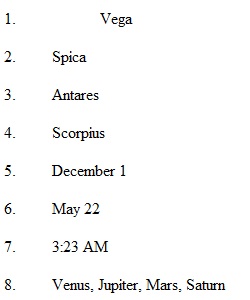


Q Astronomy widgets online The video presentation is on the Helpful Videos for Third hour K page. Use a variety of online widgets to complete a set of questions. We will start at the Sky and Telescope Magazine web site, which has several interesting applications to study the night sky. Start at their Interactive Sky Chart Links to an external site., which can be used to create a Planisphere-type view of the sky. You will see a two window display--resize your screen and viewing magnification to see both windows. Configure your page by entering the following values: • Enter Zip Code: 95677 • Year:Month:Day: 2022:May:17 • Hour:Minute: 03:30 • Under "Display Options", select all options except "Deep-sky objects," "Show daylight," and "Constellation boundaries." • Click Submit 1. 1. What named, bright star is somewhat close to the Zenith point? 2. What named, bright star is low in the west-southwestern part of the sky? Find the rectangular, green shape on the all-sky chart. You can drag this around, and its contents appear at higher magnification elsewhere on your computer screen (for my browsers, it is at top left). Now, drag the green rectangle over the Moon in the southern part of the sky. 3. What named star is close to the Moon? 4. What constellation is the Moon in? 5. Referring to your SC001 chart, on what date would the sun occupy the part of the sky that is closest to where the Moon is plotted? (Hint: the ecliptic is essential for this.) By clicking the "- day" and "+1 day" options under the "Submit" button, you can change the display date while keeping the time unchanged. 6. On what date will the Moon be nearest the planet Saturn which is in the eastern edge of constellation Capricornus? Return the time and date to the original configuration as for Question #1. 7. Using the +1 and -1 controls for hour and min, determine the time that Mars in the East had risen. Remember, "rising" means the moment that Mars touches the horizon and not just near it. 8. Seventy (70) minutes after Mars rises (as determined in the previous question), name all the planets that are visible in the sky. 9. Keeping the same date and time as in Question #8. What bright star is rising in the Southeast? Hint: Use the green rectangular close-up window to find its name. Go to the Moon Phase calculator Links to an external site.. 10. What is the phase of the Moon on 22 May 2022? Note: This should be the one of the usual 8 phases: New Moon, Waxing Crescent, First Quarter, Waxing Gibbous, Full Moon, Waning Gibbous, Third Quarter, Waning Crescent. Something like "3 Days after New Moon" is not a phase. 11. According to this page, your SC001 chart, and your logic, if the date were 22 May 2022, and the Moon was on the meridian, what time must it be? (Hint: Your answer will be either noon, sunset, sunrise, or midnight.) Go to the Moons of Jupiter calculator Links to an external site., to see the positions of the four moons that Galileo observed. In the long graphic near the top of the screen, you can see Jupiter's location, and the four satellites (Io, Europa, Ganymede, and Callisto) indicated as dots, with their initials floating nearby. 12. Set the Date to 14 May 2022, and the UT time to 00:00. Click the button labelled "Calculate using entered date and time." Click "+1 Hour" until you see the moon Io pass in front of Jupiter (You will see its black shadow on Jupiter.) At what Time (UT) is the shadow of Io closest to being centered on Jupiter (to the nearest hour)? 13. Repeatedly click the +1 Hour button to advance Io in its orbit, COUNTING EACH CLICK. Do this until Io (and its shadow) returns to its original starting point, in front of Jupiter. How many hours did it take to complete a full journey around Jupiter(remember to look for the shadow of Io to return)? 14. Return to the original time and date as in Question #12. What is the magnitude of Jupiter? Are there any stars this bright on your SC001 chart? If so, what are their names? Go to the Moons of Saturn calculator Links to an external site., to see the positions of the brightest satellites of Saturn. 1. 15. Set the time and date as in Question #12. Using the +1 Hour button to advance the time, which of the labelled satellites has the largest orbital period around Saturn? (Hint: Remember what Kepler's Third Law says about orbital periods, and orbital distances.) To turn in your answers for grading, hit the "Submit Assignment" Button in the top right and then submit all the work as text or a file upload. Make sure to number each answer. Cutting/pasting the following may help you when you are submitting your answers. 1) 2) 3) 4) 5) 6) 7) 8) 9) 10) 11) 12) 13) 14) 15) PreviousNext
View Related Questions